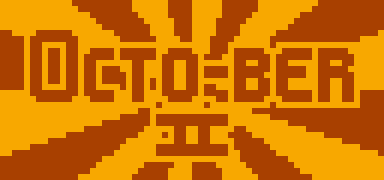|
Here's my quick implementation in C/C++ using SDL2 for graphics: https://github.com/floorislava/SDL2_Chip8_Emulator Heavily influenced by this article and code: http://www.multigesture.net/articles/how-to-write-an-emulator-chip-8-interpreter/ I'm going to add in a couple of toggles for the quirk mode stuff and make it more configurable. That and clean up the input code. It currently just uses fillrects for the pixels. Could easily be ported over to opengl with the same code.
|
|
|
|

|
| # ? May 13, 2024 19:29 |
|
I'm trying to build up a "schematic" for a Chip8 machine (memory + logic) as one of my projects. I'm compiling a list of what a typical Chip8 machine "has" and what it "does". What the machine does is simple, that's the interpreter and the opcodes, but I'm a little bit hazy on the memory structure. Does this look fair?Markdown code:Pollyanna fucked around with this message at 19:34 on Dec 7, 2014 |
|
|
|
Pollyanna posted:
If you're nitpicking the basic Chip8 has a 12-level stack. quote:Another question: where do most programs "assume" font data is located? I don't see any regularly defined addresses for the font sprites. Asked this a few posts ago. The resident CHIP8 expert said: Internet Janitor posted:Storing the font(s) in the 0x000-0x200 range is what essentially every modern chip8 interpreter does, and I think it's a safe assumption. If you check out the VIP manual I linked you'll see that the font data was originally stored in the VIP OS rom, outside of chip8's 4k addressing space entirely. Reasonable programs that use the proper font access opcodes shouldn't know or care where that data is stored. Also, progress! Chip8 for iOS now has a UI:  And can run CaveExplorer:  Purple area is a placeholder view for the keypad.
|
|
|
|
I'm being vain, but can I see a screenshot of one of my games from octojam running on your app?
|
|
|
|
Pollyanna: in general that's a correct description of how modern Chip8 interpreters work. There are a few caveats if you want to get picky:
That's coming together really nicely, shodanjr_gr! Have you tried using a nearest-neighbor upscaling routine for the display? Slightly blurry pixels is probably historically accurate for CRT displays, but I think it might look nicer with crisp rectangular pixels.
|
|
|
|
SystemLogoff posted:I'm being vain, but can I see a screenshot of one of my games from octojam running on your app? Sure, throw an Octo-style compiled program listing on paste-bin and I'll give it a shot. There's still a few programs that won't run though so don't get your hopes too high Internet Janitor posted:That's coming together really nicely, shodanjr_gr! Have you tried using a nearest-neighbor upscaling routine for the display? Slightly blurry pixels is probably historically accurate for CRT displays, but I think it might look nicer with crisp rectangular pixels. Thanks  ! My wish-list feature is to have an OpenGL-based frame buffer view with support for filters, scan-lines and different CHIP-8 computer modes. As it stands now I'm just generating a UIImage from the frame buffer array, hence the linear upscaling. ! My wish-list feature is to have an OpenGL-based frame buffer view with support for filters, scan-lines and different CHIP-8 computer modes. As it stands now I'm just generating a UIImage from the frame buffer array, hence the linear upscaling.
|
|
|
|
FYI, you can view the source code to any of the submissions in the OctoJam gallery by clicking the "source" link and then halting the program with escape or clicking the "X": http://octojam.com/games Among other things, SystemLogoff wrote the first ever Chip8 visual novel: http://johnearnest.github.io/Octo/index.html?gist=967a38d5573b2e1d5499
|
|
|
|
SystemLogoff posted:I'm being vain, but can I see a screenshot of one of my games from octojam running on your app?  Using a $900 smartphone for 8-bit Rock Paper Scissors. What has this world come to?
|
|
|
|
I'm wondering how to unit/integration test a CHIP-8 interpreter. The thing about the language is that it can run for forever if you let it, so it's a little complicated to tell your tests exactly when your tests are done. If I call chipJS.run(program), then either the program needs to finish running - which can lengthen tests and how do you determine if it's "finished'? - or you can simply have it run via setInterval(), in which case you'll need a callback in order to tell your tests that you're done - and you still have to determine a finished state. Do you run for only a set amount of time? How do you know you've gone on long enough? Does the interpreter only run until it detects an infinite loop state? If so, should it handle the exiting itself or should you do it? This is definitely something I'm not very good at wrapping my head around.
|
|
|
|
My suggestion would be:
If you don't like using 0x0000 as a halt instruction you could also look for a jump to the address of itself (in octo loop again) which is trivially detectable as an infinite loop because nothing could possibly alter its behavior. You can really tie yourself in knots dreaming up more complicated heuristics or rules of this sort but they'll never generalize. Keep it simple. Testing input is inherently fiddly and probably needs a different strategy if it's worth automated testing at all.
|
|
|
|
Internet Janitor posted:My suggestion would be: That's how I'm handling things in my interpreter as well and seems to be working fine so far.
|
|
|
|
Hey, quick question. I'm new to this. How do I incrementally load through stuff from a memory block Let's say I have code:I thought this would be something like: code:
|
|
|
|
The load and store opcodes modify the contents of the i register, incrementing it by the number of bytes you load or store. If you aren't doing anything which modifies i in "do stuff" you could simply do:code:code:code:
|
|
|
|
Thanks, yeah I somehow missed that i got auto incremented on save/load. Works now. Working on a project for fun that should hopefully not take too long  CHIP-8 seems fun.
|
|
|
|
So yeah, the octo debugger is pretty sweet. Got bitten by this (but found it out while debugging): Opcode Description 8XY4 Add the value of register VY to register VX Set VF to 01 if a carry occurs Set VF to 00 if a carry does not occur 8XY5 Subtract the value of register VY from register VX Set VF to 00 if a borrow occurs Set VF to 01 if a borrow does not occur I assumed that VF would be 01 if a borrow occured, cause yeah, that would make more sense right? Buffis fucked around with this message at 16:13 on Dec 30, 2014 |
|
|
|
Oh yeah. I made the same mistake the first time I implemented those opcodes. It's one of several reasons I created the < > <= >= pseudo-ops.
|
|
|
|
Internet Janitor posted:Oh yeah. I made the same mistake the first time I implemented those opcodes. It's one of several reasons I created the < > <= >= pseudo-ops. To be fair, I also got bitten by compare-temp overriding ve for me when I didn't expect it to  That said, now that I realized that compare-temp is a thing, the pseudo-ops are pretty great.
|
|
|
|
Been playing around with Octo a bit more. Have a pretty stable bullet engine going now, that I might turn into something cool. Here's a quick demo of a pretty simple pattern: http://johnearnest.github.io/Octo/index.html?gist=74f43dac16b313b60a25 Pattern above is only something like 12 bullets onscreen at the time max. Currently the engine can do 25 bullets on screen without any real issues. I'm in the process of cutting down the bullet structures to 8 bytes (from 10) though, which will allow me to address 32 bullets wit 8-bit addressing. If that's not enough, it shouldn't be super hard to extend it to 16 bit addresses for the bullets. The implementation for acceleration is kindof lovely right now, but it's functional. The pattern generation is pretty easy right now. Essentially, bullets are spawn by doing code:The example above is: code:http://johnearnest.github.io/Octo/index.html?gist=005dc11e44cd16fee1b0 Buffis fucked around with this message at 14:35 on Jan 1, 2015 |
|
|
|
That's a pretty cool start! Reminds me of Noiz. If you want to try to improve performance and shave some bytes off your code you might want to play around with some inlining. The body subroutine never returns, so you could just replace your current main. The pew_pew subroutine is too short for you to come out ahead on cycles or ram. I assume you have it broken out so you can alter the size of the struct you write out in just one place- an alternative is to use an alias: code:
|
|
|
|
Yeah, I haven't bothered too much with optimization yet, since I just wrote the engine for 25 bullets to start with, and everything works mostly ok with that as long as I draw everything before the computation (at 1000 cycles per frame that is). There's a lot of optimization to do for sure, but I'll try to mash this into something playable first. The jump table idea sounds pretty nice. Might try that out!
|
|
|
|
Posting a work in progress, since Internet Janitor asked me to. danm8ku.8o: http://johnearnest.github.io/Octo/index.html?gist=425acca04b1f79e47eb4 Controls are : WASD  The engine for this is actually a lot more capable than for this simple pattern though. It supports 32 on screen bullets with individual x/y speed and acceleration. The ROM is <500 bytes currently, but it allocates 256 bits of additional memory for the actual bullet engine on startup. Basically, I wanted to see how small I could get the ROM cause I was bored. Might implement something a bit more advanced like a boss with multiple stages + a title screen at some point, making this a bit more than just the very simple bullet dodger that it is right now. Still, I'm kindof pleased with this. Code is pretty easy to read, and the "API" for spawning bullets are easy as gently caress. Current pattern is just: code:Adding new more advanced patterns is very easy. Buffis fucked around with this message at 08:16 on Jan 16, 2015 |
|
|
|
Goddamn, that's cool. I really need to get into games development, like, for real instead of just posting about it on the internet. In related news though, we showed our projects at a meet & greet recently and everyone was blown away by my explanation of my Javascript virtual machine  It's really funny to me, cause it feels like something very basic and that needs infinitely more iteration to even get close to Octo, yet people are like "woah bitshifting goddamn". I suppose it's a boost to my ego, but... It's really funny to me, cause it feels like something very basic and that needs infinitely more iteration to even get close to Octo, yet people are like "woah bitshifting goddamn". I suppose it's a boost to my ego, but...
|
|
|
|
This is a neat project- a guy gamed Doug Crawford used Octo to write a proof-of-concept spreadsheet in Chip8 and ran it on a real COSMAC VIP: https://abitoutofplace.wordpress.com/2015/05/02/cosmaccalc-the-cosmac-vip-s-place-in-spreadsheet-history/ Don't miss the video either: https://www.youtube.com/watch?v=6KCUhjaCdjo I've been exchanging some emails with the author to try to extend Octo with the ability to emulate a cassette drive so that the couple dozen people who own a VIP can develop more efficiently. I have something sort of working but it's surprisingly difficult to get the waveforms just right to make the VIP happy. At any rate it's really fun to see Octo being useful for developing against real hardware.
|
|
|
|
I thought October was next month and was all hyped up for Octojam  I think I might make a couple test things in it to reacquaint myself.
|
|
|
|
I made this and I'm happy with it even though it's awful: http://johnearnest.github.io/Octo/index.html?gist=196954a72f816e8302f7 Edit: Updated program to reflect changes to XO-Chip. TomR fucked around with this message at 23:04 on Sep 19, 2015 |
|
|
|
Rumblings are beginning again on the Octo project. I just started writing a guide to SuperChip for the docs, since there aren't many good references beyond the original SCHIP manual. Additionally, I have created a Google Group to allow non-SA users to share programs and ask questions. Look forward to more improvements and cleanups to Octo in the coming weeks. If there are any topics you'd like to see discussed more or better in the documentation or you encounter any bugs, please let me know!
|
|
|
|
I have made some small changes to XO-Chip to address things I was unhappy with. Firstly, the syntax of the audio := i instruction was changed to simply audio. The former seemed to imply that the value of i itself was being copied rather than the indirect buffer and I thought this was confusing. Secondly, and more significantly, the bank instructions have been entirely replaced. Banked memory causes all kinds of hell for disassembly and introduces all sorts of nasty memory layout decisionmaking during programming which Chip8 is otherwise pleasantly not required to deal with. Instead, I have created a double-wide instruction which can load a 16-bit address in i. Just use a long modifier before an address: code:Hopefully these changes won't hurt any programs in the wild. The compiler, emulator, disassembler and documentation have all been updated to reflect these changes and excepting bugfixes I think XO-Chip is now final. edit: I'm also checking in a few older example programs. I was able to make a crude but flexible music player in surprisingly little code using the XO-Chip audio subsystem. Internet Janitor fucked around with this message at 00:56 on Sep 20, 2015 |
|
|
|
I realized that I haven't actually posted Trucksimul8or in this thread so... Here was my entry for SAGDC, written in Octo. http://www.awfuljams.com/games/truck-simul8or http://johnearnest.github.io/Octo/index.html?gist=a8a227e707cd138ba258 It's a truck simulator game without a truck, featuring customization and insane trucking action. The gong show video showing it off was pretty cool: https://www.youtube.com/watch?v=rXC5iCdDm8Q&t=3s
|
|
|
|
I hope you folks are ready, because it's nearly that time again: http://octojam.com Please spread the word!
|
|
|
|
4 colors is pretty cool http://johnearnest.github.io/Octo/index.html?gist=306e51072134d6793f99
|
|
|
|
To help people get into putting their terribly-sampled audio into Octo via XO-Chip, I wrote Chipify, a Python script that takes mono WAV files, smashes them into 1-bit 4000 Hz format, and spits out hex strings you can paste into Octo. This is extremely simple. I apply a low-pass filter to knock off all frequencies that are higher than 4000 Hz so that they don't get turned to noise when the sample rate is reduced. Then, I take the average of all of the high-resolution samples for a given low-resolution sample to crush it down into 4000 Hz, and then round the waveform to the nearest whole number. Here's a couple of examples: Heh, I chipped your mom's eight last night A faithful reproduction of my singing voice Chipifying even simple music produces interesting results e: Then of course IRC wanted me to chipify a bunch more bullshit, so: I'LL BE BACK GHOST! BUSTERS!! (taken from the really lovely NES sound) A modem dialing Mabe Village from Link's Awakening You're Correct Horse.wav blastron fucked around with this message at 23:38 on Sep 30, 2015 |
|
|
|
UNDERTALE SPOILERS BELOW http://johnearnest.github.io/Octo/index.html?gist=21d9b38ddb913e2e2ac8 (code is pretty hacky, quick and dirty prototype)
|
|
|
|
Buffis posted:UNDERTALE SPOILERS BELOW http://johnearnest.github.io/Octo/index.html?gist=08674a582a6e77fc6859
|
|
|
|
I'm trying to sleep and all I can think about is bytes. Don't octo too hard kids (but do octo!)
|
|
|
|
Tann posted:I'm trying to sleep and all I can think about is bytes. Don't octo too hard kids (but do octo!) im permabanned poster octohacker58. i first started hacking octo...
|
|
|
|
I made a music player. http://johnearnest.github.io/Octo/index.html?gist=d200d276b8a2c3ef5e65 V and C change tempo, X erases the track. 1 2 3 4 Q add bits to the note to be played. Hold X while playing to make a new note. Edit: I made a video of how to play. https://www.youtube.com/watch?v=evM38ScUMAE TomR fucked around with this message at 14:45 on Oct 4, 2015 |
|
|
|
Buffis fucked around with this message at 08:23 on Oct 5, 2015 |
|
|
|
Just discovered this on the Ludlum Dare site: http://ludumdare.com/compo/ludum-dare-33/?action=preview&uid=41319 Was it one of you folks?
|
|
|
|
I made some major changes to my music player. It has lots of controls now. It will play 8 pages of music now. http://johnearnest.github.io/Octo/index.html?gist=98f62541b3c8177360ba Edit: I've included 3 songs. Hold E (f on your keyboard) to skip to the next song. TomR fucked around with this message at 00:30 on Oct 5, 2015 |
|
|
|

|
| # ? May 13, 2024 19:29 |
|
The Gameduino Project guy did a (porting and such) thing apparently: http://excamera.com/sphinx/article-chip8.html#chip8
|
|
|
















